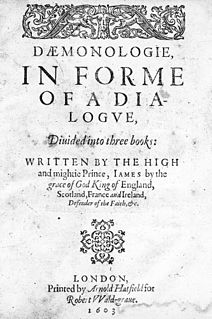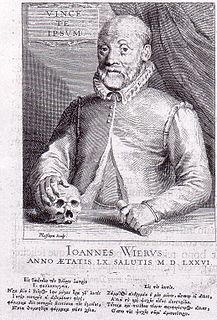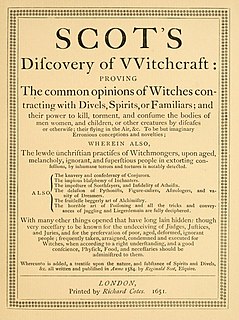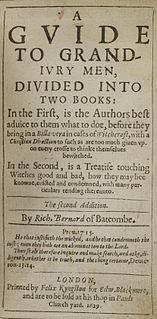 W
WCompendium Maleficarum is a witch-hunter's manual written in Latin by Francesco Maria Guazzo, and published in Milan, Italy in 1608.
 W
WDaemonologie—in full Daemonologie, In Forme of a Dialogue, Divided into three Books: By the High and Mighty Prince, James &c.—was written and published in 1599 by King James VI of Scotland as a philosophical dissertation on contemporary necromancy and the historical relationships between the various methods of divination used from ancient black magic.
 W
WDe praestigiis daemonum, translated as On the Tricks of Demons, is a book by medical doctor Johann Weyer, also known as Wier, first published in Basel in 1563. The book argues that witchcraft does not exist and that those who claim to practice it are suffering from delusions, which should be treated as mental illnesses, rather than punished as witchcraft. It was influential in the abolishment of witchcraft trials in the Netherlands.
 W
WThe Directorium Inquisitorum is Nicholas Eymerich's most prominent and enduring work, written in Latin and consisting of approximately 800 pages, which he had composed as early as 1376. Eymerich had written an earlier treatise on sorcery, perhaps as early as 1359, which he extensively reworked into the Directorium Inqusitorum. In compiling the book, Eymerich used many of the magic texts he had previously confiscated from accused sorcerers. It can also be considered as an assessment of a century and half of official Inquisition in the "albigensian" country.
 W
WThe Discoverie of Witchcraft is a partially sceptical book published by the English gentleman Reginald Scot in 1584, intended as an exposé of early Modern witchcraft. It contains a small section intended to show how the public was fooled by charlatans, which is considered the first published material on illusionary or stage magic.
 W
WFrancesco Maria Guazzo, aka Guaccio, aka Guaccius (1570–16??) was an Italian priest. Is most well known for the writing the Compendium Maleficarum.
 W
WA Guide to Grand-Jury Men — in full, A Guide to Grand Jury Men, Divided in two books. In the first, is the Author's best advice to them what to do, before they bring in a Billa vera in cases of Witchcraft, with a Christian Direction to such as are too much given upon every cross to think themselves bewitched. In the Second, is a Treatise touching Witches good and bad, how they may be known, evicted, condemned, with many particulars tending thereunto was first published in 1627 and written by a puritan clergyman named Richard Bernard.
 W
WThe work commonly referred to as Laienspiegel is a book of law. It was published in Augsburg, in 1509. Its full title is ″Laijen Spiegel. von rechtmässigen ordnungen in Burgerlichen vnd peinlichen regimenten. mit allegation[en] vn[d] bewerungen auß geschribnen rechten vnnd gesatzen“.
 W
WThe Malleus Maleficarum, usually translated as the Hammer of Witches, is the best known treatise on witchcraft. It was written by the Catholic clergyman Heinrich Kramer and first published in the German city of Speyer in 1486. It endorses extermination of witches and for this purpose develops a detailed legal and theological theory. It has been described as the compendium of literature in demonology of the 15th century. The top theologians of the Inquisition at the Faculty of Cologne condemned the book as recommending unethical and illegal procedures, as well as being inconsistent with Catholic doctrines of demonology.
 W
WNewes from Scotland - declaring the damnable life and death of Dr. Fian, a notable sorcerer is a pamphlet printed in London in 1591, and likely written by James Carmichael, who later advised King James VI on the writing of his book Daemonologie. It describes the infamous North Berwick witch trials in Scotland and the confessions given before the King. It was subsequently published in Daemonologie by King James in 1597.
 W
WTraité sur les apparitions des esprits et sur les vampires ou les revenans de Hongrie, de Moravie, &c. is one of the many works by an Abbot monk named Antoine Augustin Calmet, an exegete and an 18th century Lorraine scholar of the Benedictine Order; also known as Dom Calmet. The work was published in 2 volumes that dealt with the extensive investigation into occult matters regarding the apparitions of angels, demons and other spirits.